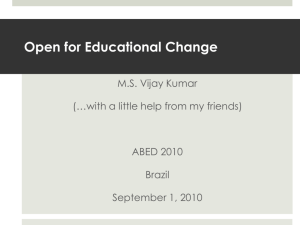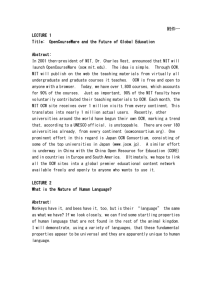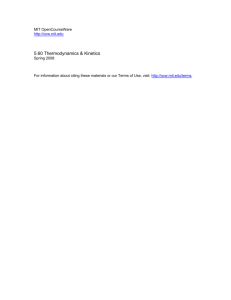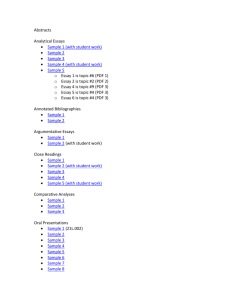Open for IIHS
advertisement
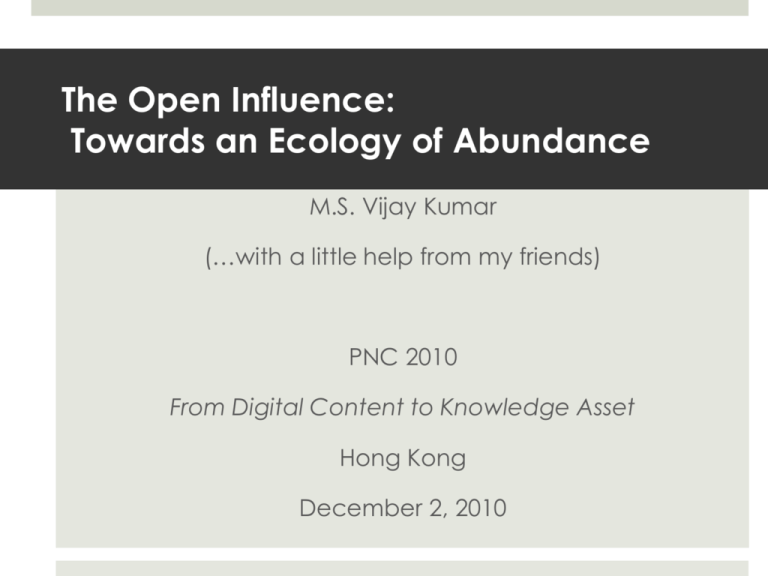
The Open Influence: Towards an Ecology of Abundance M.S. Vijay Kumar (…with a little help from my friends) PNC 2010 From Digital Content to Knowledge Asset Hong Kong December 2, 2010 Network-enabled Open Education Click to edit Master title style Open Network Content Connectivity Tools People/Communiti es Knowledge Resources Activities Enabling Resources Legal Policy Quality Educational Opportunity Accelerating Global Movement OUI NPTEL 200+ OCWC Institutions ~ 10,000 Courses Online ~2,000,000 visitors/month IGNOU K-12 Open Education Resources Tools Learning Content Full courses, course materials, content modules, learning objects, collections, journals Software to support the creation, delivery, use and improvement of open learning content including searching and organization of content, content and learning management systems, content development tools, and on-line learning communities. Implementation Resources Intellectual property licenses to promote open publishing of materials, design-principles, and localization of content. OER as Key Strategy for Educational Advancement 6 Commonwealth of Learning International Council for Distance Education (ICDE) EADTU UNESCO Open Textbook Initiatives India: National Knowledge Commission Capacity Building through Net Enabled Open education Part of the Discourse on Educational Change India: Capacity Building through Net Enabled Open education Network-based delivery needs to become a central modality for delivering quality education. A blended process – intelligent combinations of physical and virtual elements. Distributed Repositories, Domain-specific Grids and Portals, Interaction facilities, Robust connectivity Faculty and Institutional Development Program Promote distance and network based delivery techniques Develop domain competencies and teaching skills for quality education using quality faculty and high quality materials. National Portal for Open Education Enabling resources for faculty and resource development Clearinghouse function and an interaction environment A Collaborative Publication Project 8 • “How can we advance teaching and learning by taking full advantage of open education?” • A hardcover book + free online distribution with Creative Commons • 30 chapters by 38 prominent leaders and visionaries (Foreword by John Seely Brown) • Lessons learned and visions of the future from: OKI, IMS, CNI, Sakai, Moodle, ETUDES, iCampus, VUE, Mellon Foundation, OCW, Connexions, OLI, MERLOT, OpenLearn, SOFIA, Creative Commons, LAMS, Hewlett Foundation, CASTL, VKP, ISSOTL, Open University, Carnegie Foundation, and more The Carnegie Foundation’s Book on Open Education (Winter 2008, MIT Press) Opening Up Education: A Framework 9 Open Technology Open Content Open Knowledge Section Editor: Owen McGrath Section Editor: Flora McMartin Section Editor: Cheryl Richardson Trent Batson Steve Ehrmann David Kahle M. S. Vijay Kumar Stuart Lee Phil Long Clifford Lynch Christopher Mackie Neeru Paharia Edward Walker Richard Baraniuk Tom Carey Catherine Casserly Gerard Hanley Diane Harley Andy Lane Steve Lerman Anne Margulies Shigeru Miyagawa Marshall Smith Candace Thille David Wiley Randy Bass Dan Bernstein Barbara Cambridge James Dalziel Bernadine Chuck Fong Richard Gale Mary Huber Pat Hutchings Toru Iiyoshi Diana Laurillard Marilyn Lombardi 10 Opening Up Education: Key Dimensions What does open education mean as an agency for change both in formal and informal education? The educational value proposition and implications of open education initiatives The factors that would propel these initiatives towards having a larger impact on education. MIT OpenCourseware 1900+courses Site Highlights Syllabus Course Calendar Lecture Notes Exams Problem/Solution Sets Labs and Projects Video Lectures Making A Difference “Last semester, I had a course in metallurgical engineering. I didn’t have notes, so I went to OCW. I downloaded a course outline on this, and also some review questions, and these helped me gain a deeper understanding of the material.” — Kunle Adejumo, Engineering student at Ahmadu Bello University, Zaria, Nigeria Making A Difference “I was delighted by the way the material is so coherently presented. It is truly inspiring to see this level of excellence.” — Prof. Richard Hall, LaTrobe University, Melbourne, Australia Teaching Information Systems, Beginning Microprocessors, and Advance Computer-Aided Software Engineering Making A Difference “It’s not simply the information that’s valuable, but also the glimpse OCW offers into how MIT has structured its teaching and research.” - Professor Triatno Harjoko, Head of Department of Architecture at University of Depok, Indonesia, is using OCW to add interactivity to architecture instruction by his faculty. Flashback - Flashforward “… even though I relied heavily on material from [Differential Equations], I had no idea how it was being taught—or what was being taught. … I’d like to bring more of the technology into the classroom, so that while I was giving a lecture, I could give them a flashback to something they had seen in a previous course… This will create better linkages, and to fully integrate the learning experience.” — Prof. Karen Willcox, Aeronautics & Astronautics Teaches required aero/astro course to MIT juniors Open Teaching Transformative Potential: Changing the Ecology and Economics of Education Access; Alternate Pathways; Adaptation; A Teaching Learning Scaling Excellence: Overcome the Iron Triangle of AQC (Daniel) Blended BB Learning oundary-less Education Continuous improvement C Continuous Education Linking Content to the Curriculum Multimedia and Image Tools Spoken Lecture Browser Bringing close reading to media (xmas) • Leveraging Content across Courses Visual narratives (Visualizing Cultures) • Media Notebooks • Deeper Learning Searching across media repositories 10 MIT Visualizing Cultures iLabs: “If you can’t come to the lab… the lab will come to you!” Dynamic signal analyzer (EECS, 2004) Shake table (Civil Eng., 2004) U.S., Australia, China, India, Africa: iLabs Consortium Order of magnitude more lab experiences More lab time to users/researchers More sophisticated labs available Communities of scholars created around iLabs Sharing educational & research content Deeper Learning and Leveraged Resources The Demo http://spokenmedia.mit.edu/demo/iihs/ http://spokenmedia.mit.edu/demo/iihs/ 22 Process and Platform for Collaborative Course & Curriculum : Finding Getting Building Discover For example… MIT OCW OCW Consortium Academic Earth Wikipedia NPTEL iTunesU YouTube Collaborate Collect Learning Activities Learning Objectives Content Construct VUE-Search for content 24 Student Experience-Add Timeline, Context 25 Look for recommender resources 26 Open …Readiness 27 What factors would help Open initiatives have a larger impact on education? How can we tightly integrate open education efforts with educational program priorities? Readiness Content and Culture “Water, Water, Everywhere, Nor any drop to drink.” — Coleridge, The Rime of the Ancient Mariner Content Readiness Addressing challenge of effectively finding, evaluating and making the best use resources in one’s own educational context. Cultural Readiness Embracing a culture of open in educational design, development, and delivery By Educators and Institituions , from the get-go. Content Readiness: Finding….. Getting…. Using Content Discovery and Re-use link existing educational materials and aid in their discoverability ; making it easier to utilize relevant educational materials in teaching and learning. Community and Context: Collective intelligence: Social tagging and social networking tools to help find useful materials more quickly and to share best practice Collaborative Annotation tools that will enable sharing of information and ideas through annotation of content in text, web, video. Core Concept Catalog: Curriculum concepts, or “learning objectives”, mapped to OCW materials enabling the re-use of cross-disciplinary content. Point of Need Learning; Guided Pathways Challenge: Recasting Resources, Relationships and Roles Institutional Inertial Frames and Invariants Scarcity vs. Abundance Recasting roles and values Sense Making Ordering the digital disorder Pedagogical Shifts Individual learning -> collaborative, social learning Co-development of knowledge with learners Credentialing Distributed over time and place P2P and Self-Learning We are seeing the early emergence of a meta-university atranscdent Thank You M.S. Vijay Kumar vkumar@mit.edu http://web.mit.edu/~vkumar/www/ 3/12/2016 In Search of Useful Open Resources OCW Finder :: ocwfinder.org Search and browse across OCWs OCW Consortium also has a search at www.ocwconsortium.org/use/use-dynamic.html OER Recommender :: oerrecommender.org “Related” resources from selected collections Plug-in for Firefox KEEP/Knowledge Commons Tacit Knowledge Open Knowledge Initiative (O.K.I) OSIDS – Specifications for Portability, Interoperability 33 Project Greenfield http://greenfield.mit.edu 34 Resource Sites web.sls.csail.mit.edu spokenmedia.mit.edu ocwfinder.org www.ocwconsortium.org/use/use-dynamic.html www.folksemantic.com oeit.mit.edu vue.tufts.edu nptel.iitm.ac.in http://web.mit.edu/ocwhq/intel/contentreview/index.html) http://cnx.org/aboutus/technology/cnxml) Network Enabled Open Education Open Network Content Tools Knowledge Enabling Resources Legal Policy Connectivity Wired; Wireless Satellite; Cell; Mesh…… Community Quality Educational Opportunity Accelerated Learning – OLI Challenges Conventional Wisdom Bridging Research and Learning Hydrology Biology star.mit.edu Protein Visualization (StarBiochem) Watershed Mapping (StarHydro) 8 16.00AJ - Fundamentals of Engineering Design: Explore Space, Sea & Earth NPTEL 40
